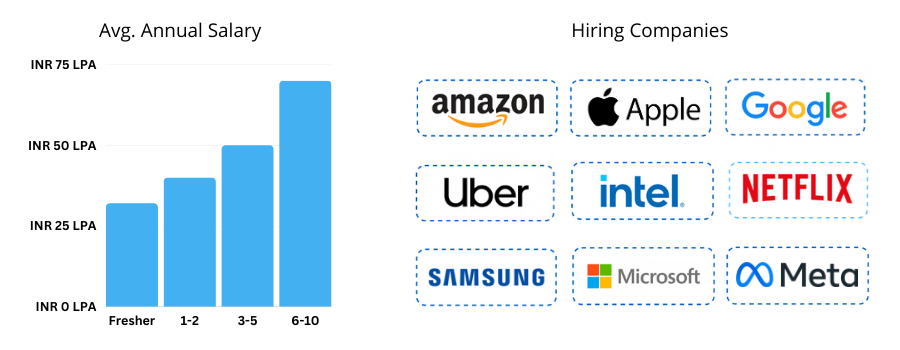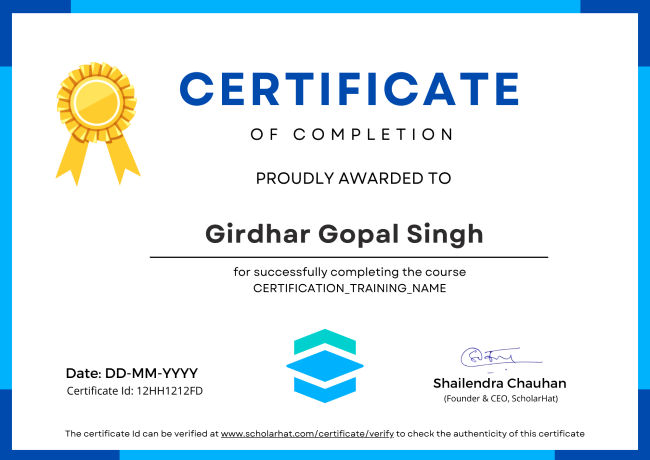Hands-On Labs Labs(145)
 Java: Calculate Standard deviation
Java: Calculate Standard deviation
00:15:00
 Java: Calculate the Area of a Square
Java: Calculate the Area of a Square
00:15:00
 Java: Create a Calculator Class to Perform Add, Subtract, Multiply and Divide operations for two numbers
Java: Create a Calculator Class to Perform Add, Subtract, Multiply and Divide operations for two numbers
00:20:00
 Java: Check whether a Year is Leap Year or Not
Java: Check whether a Year is Leap Year or Not
00:10:00
 Java: Count the frequency of an element in an Array
Java: Count the frequency of an element in an Array
00:20:00
 Java: Construct a linked list from 2D matrix
Java: Construct a linked list from 2D matrix
00:30:00
 Java: Reverse a Stack using Recursion
Java: Reverse a Stack using Recursion
00:25:00
 Java: Ceiling in a Sorted Array
Java: Ceiling in a Sorted Array
00:25:00
 Java: Check whether a Binary Tree is BST or Not
Java: Check whether a Binary Tree is BST or Not
00:30:00
 Java: Deletion in a Binary Tree
Java: Deletion in a Binary Tree
00:40:00
 Java: Transpose Graph
Java: Transpose Graph
00:40:00
 Java: Two Sum
Java: Two Sum
00:30:00
 Java: Two Sum
Java: Two Sum
00:30:00
 Java: Find next right node of a given key
Java: Find next right node of a given key
00:30:00
 Java: Big-O-Binary Search Algorithm
Java: Big-O-Binary Search Algorithm
00:15:00
 Java: Traversing directory in Java using BFS
Java: Traversing directory in Java using BFS
00:20:00
 Java: Contains Duplicate
Java: Contains Duplicate
00:20:00
 Java: Merge Sorted Arrays
Java: Merge Sorted Arrays
00:25:00
 Java: Count Number of Trees in a Forest
Java: Count Number of Trees in a Forest
00:40:00
 Java: Check if two nodes are cousins in a Binary Tree
Java: Check if two nodes are cousins in a Binary Tree
00:50:00
 Java: Check whether the two Binary Search Trees are Identical or Not
Java: Check whether the two Binary Search Trees are Identical or Not
00:35:00
 Java: Count 1’s in a Sorted Binary Array
Java: Count 1’s in a Sorted Binary Array
00:20:00
 Java: Delete consecutive same words in a sequence
Java: Delete consecutive same words in a sequence
00:25:00
 Java: Convert given Binary Tree to Doubly Linked List in Linear Time
Java: Convert given Binary Tree to Doubly Linked List in Linear Time
00:25:00
 Java: Find all triplets with zero sum
Java: Find all triplets with zero sum
00:20:00
 Java: Display the Fibonacci Series
Java: Display the Fibonacci Series
00:20:00
 Java: Create A Student Class for Listing, Adding and Removing a Student
Java: Create A Student Class for Listing, Adding and Removing a Student
00:25:00
 Java: Sum Of All Numbers
Java: Sum Of All Numbers
00:15:00
 Java: Calculate Average of Array Element
Java: Calculate Average of Array Element
00:15:00
 Java: Find The Largest Element of an Array
Java: Find The Largest Element of an Array
00:15:00
 Java: Swap Number Without Third Variable
Java: Swap Number Without Third Variable
00:25:00
 Java: Create an Exception Class to Display a Custom Error Message Based on the Exception Type
Java: Create an Exception Class to Display a Custom Error Message Based on the Exception Type
00:25:00
 Java: Find The Highest Common Factor (HCF) Or Greatest Common Divisor (GCD)
Java: Find The Highest Common Factor (HCF) Or Greatest Common Divisor (GCD)
00:25:00
 Java: Leaders in an array
Java: Leaders in an array
00:20:00
 Java: Count Nodes in Circular Linked List
Java: Count Nodes in Circular Linked List
00:25:00
 Java: Sort a Stack using another stack
Java: Sort a Stack using another stack
00:30:00
 Java: Find a Fixed Point (Value equal to Index) in given Array
Java: Find a Fixed Point (Value equal to Index) in given Array
00:25:00
 Java: Find the Closest Element in Binary Search Tree
Java: Find the Closest Element in Binary Search Tree
00:35:00
 Java: Convert Binary Tree to Doubly Linked List
Java: Convert Binary Tree to Doubly Linked List
00:50:00
 Java: Depth First Search or DFS for a Graph
Java: Depth First Search or DFS for a Graph
00:40:00
 Java: Search Insert Position
Java: Search Insert Position
00:25:00
 Java: Longest Substring without Repeating Characters
Java: Longest Substring without Repeating Characters
00:30:00
 Java: Minimum time required to rot all oranges
Java: Minimum time required to rot all oranges
00:40:00
 Java: Group Anagrams
Java: Group Anagrams
00:35:00
 Java: First Bad Version
Java: First Bad Version
00:30:00
 Java: Breadth First Search or BFS for a Graph
Java: Breadth First Search or BFS for a Graph
00:40:00
 Java: Height of a Generic Tree from Parent Array
Java: Height of a Generic Tree from Parent Array
00:50:00
 Java: Insertion in a Binary Tree in Level Order
Java: Insertion in a Binary Tree in Level Order
00:35:00
 Java: Search an Element in a Sorted and Rotated Array
Java: Search an Element in a Sorted and Rotated Array
00:30:00
 Java: Next Greater Element
Java: Next Greater Element
00:30:00
 Java: Delete all Prime Nodes from a Doubly Linked List
Java: Delete all Prime Nodes from a Doubly Linked List
00:35:00
 Java: Meeting Rooms
Java: Meeting Rooms
00:25:00
 Java: Find The Factorial Of A Number
Java: Find The Factorial Of A Number
00:25:00
 Java: Create Classes for Building Different Types of Vehicles like Bikes, Scooters, Cars in a Factory
Java: Create Classes for Building Different Types of Vehicles like Bikes, Scooters, Cars in a Factory
00:25:00
 Java: Swap Number with Second Variable
Java: Swap Number with Second Variable
00:20:00
 Java: Check if an Array contains a Given Values
Java: Check if an Array contains a Given Values
00:15:00
 Java: Concatenate Two Arrays
Java: Concatenate Two Arrays
00:15:00
 Java: Create Classes for Employee
Java: Create Classes for Employee
00:25:00
 Java: Find the Lowest Common Multiple(LCM)
Java: Find the Lowest Common Multiple(LCM)
00:25:00
 Java: Merge Two Sorted Arrays
Java: Merge Two Sorted Arrays
00:20:00
 Java: Deletion from a Circular Linked List
Java: Deletion from a Circular Linked List
00:35:00
 Java: Trapping rain water
Java: Trapping rain water
00:30:00
 Java: Two Elements whose Sum is Closest to Zero
Java: Two Elements whose Sum is Closest to Zero
00:30:00
 Java: Find right Sibling of a binary tree with parent pointers
Java: Find right Sibling of a binary tree with parent pointers
00:40:00
 Java: Find Distance between two nodes of a Binary Tree
Java: Find Distance between two nodes of a Binary Tree
00:50:00
 Java: Find Peak Element
Java: Find Peak Element
00:30:00
 Java: Valid Sudoku
Java: Valid Sudoku
00:40:00
 Java: Subarray Sum Equals K
Java: Subarray Sum Equals K
00:25:00
 Java: Search in Rotated Sorted Array
Java: Search in Rotated Sorted Array
00:25:00
 Java: Binary Tree to Binary Search Tree Conversion
Java: Binary Tree to Binary Search Tree Conversion
00:40:00
 Java: Search in an Almost Sorted Array
Java: Search in an Almost Sorted Array
00:25:00
 Java: Largest rectangle in histogram
Java: Largest rectangle in histogram
00:25:00
 Java: Remove Duplicates from a sorted Linked List
Java: Remove Duplicates from a sorted Linked List
00:25:00
 Java: Minimum Number of Jumps to Reach End in Array
Java: Minimum Number of Jumps to Reach End in Array
00:25:00
 Java: Check whether a Number is Palindrome or Not
Java: Check whether a Number is Palindrome or Not
00:15:00
 Java: Create Classes for Handling Different Bank Accounts (Saving and Current) Submit, Withdrawal
Java: Create Classes for Handling Different Bank Accounts (Saving and Current) Submit, Withdrawal
00:20:00
 Java: Check if a String is Numeric
Java: Check if a String is Numeric
00:15:00
 Java: Compare two Strings
Java: Compare two Strings
00:15:00
 Java: Check Number Is Armstrong Or Not
Java: Check Number Is Armstrong Or Not
00:20:00
 Java: Move all Zeros to the beginning of an array
Java: Move all Zeros to the beginning of an array
00:25:00
 Java: Reverse a Doubly Linked List
Java: Reverse a Doubly Linked List
00:20:00
 Java: Find the Factorial of a Number Using Recursion
Java: Find the Factorial of a Number Using Recursion
00:15:00
 Java: Median of Two Sorted Arrays of Different Sizes
Java: Median of Two Sorted Arrays of Different Sizes
00:30:00
 Java: 3 Sum
Java: 3 Sum
00:25:00
 Java: Minimum Window Substring
Java: Minimum Window Substring
00:30:00
 Java: Design HashSet
Java: Design HashSet
00:25:00
 Java: Search a 2D Matrix
Java: Search a 2D Matrix
00:20:00
 Java: A Pair with a Given Sum in the Rotated Sorted Array
Java: A Pair with a Given Sum in the Rotated Sorted Array
00:25:00
 Java: Traversal of Circular Linked List
Java: Traversal of Circular Linked List
00:25:00
 Java: Remove Duplicates from an Array
Java: Remove Duplicates from an Array
00:20:00
 Java: Check whether a Number Is Prime or Not
Java: Check whether a Number Is Prime or Not
00:20:00
 Java: Iterate through each Character of the String
Java: Iterate through each Character of the String
00:15:00
 Java: Convert Binary Numbers to Decimals
Java: Convert Binary Numbers to Decimals
00:20:00
 Java: Check if a String is a palindrome or not
Java: Check if a String is a palindrome or not
00:20:00
 Java: Count the Vowel and Consonants in a Sentence
Java: Count the Vowel and Consonants in a Sentence
00:20:00
 Java: Rotate a Matrix by 90 degrees
Java: Rotate a Matrix by 90 degrees
00:25:00
 Java: Display Armstrong Numbers With Intervals
Java: Display Armstrong Numbers With Intervals
00:20:00
 Java: Sort Elements by Frequency
Java: Sort Elements by Frequency
00:30:00
 Java: Iterative Depth First Traversal of Graph
Java: Iterative Depth First Traversal of Graph
00:30:00
 Java: Find Minimum in Rotated Sorted Array
Java: Find Minimum in Rotated Sorted Array
00:25:00
 Java: Find Minimum in Rotated Sorted Array II
Java: Find Minimum in Rotated Sorted Array II
00:35:00
 Java: Detect Cycle in a Directed Graph
Java: Detect Cycle in a Directed Graph
00:30:00
 Java: Sort a Linked List of 0s, 1s and 2s
Java: Sort a Linked List of 0s, 1s and 2s
00:35:00
 Java: Display Prime Numbers Between Intervals
Java: Display Prime Numbers Between Intervals
00:15:00
 Java: Rotate an Array to the left
Java: Rotate an Array to the left
00:20:00
 Java: To Make A Calculator For Addition Subtraction Multiplication and Division Of Two Numbers
Java: To Make A Calculator For Addition Subtraction Multiplication and Division Of Two Numbers
00:25:00
 Java: Capitalize the First Character of Each Word in a String
Java: Capitalize the First Character of Each Word in a String
00:15:00
 Java: To Print A Number Table Using Loops
Java: To Print A Number Table Using Loops
00:15:00
 Java: Right Triangle Star Pattern
Java: Right Triangle Star Pattern
00:15:00
 Java: Camel Case of a given Sentence
Java: Camel Case of a given Sentence
00:20:00
 Java: Reverse A Sentence Using Recursion
Java: Reverse A Sentence Using Recursion
00:20:00
 Java: Find Missing Elements of a Range
Java: Find Missing Elements of a Range
00:25:00
 Java: Detect Cycle in an Undirected Graph
Java: Detect Cycle in an Undirected Graph
00:30:00
 Java: Dijkstra’s Shortest Path Algorithm
Java: Dijkstra’s Shortest Path Algorithm
00:40:00
 Java: Sort a Nearly Sorted (or K sorted) Array
Java: Sort a Nearly Sorted (or K sorted) Array
00:20:00
 Java: Count ways to increase LCS length of two Strings by one
Java: Count ways to increase LCS length of two Strings by one
00:25:00
 Java: Minimum rotations required to get the same string
Java: Minimum rotations required to get the same string
00:15:00
 Java: Left Triangle Star Pattern
Java: Left Triangle Star Pattern
00:15:00
 Java: Chocolate Distribution Problem
Java: Chocolate Distribution Problem
00:30:00
 Java: Minimum Swaps required to convert binary tree to binary search tree
Java: Minimum Swaps required to convert binary tree to binary search tree
00:30:00
 Java: Pyramid Star Pattern
Java: Pyramid Star Pattern
00:15:00
 Java: Multiply Large Numbers represented as Strings
Java: Multiply Large Numbers represented as Strings
00:25:00
 Java: Find Itinerary from a given list of tickets
Java: Find Itinerary from a given list of tickets
00:25:00
 Java: Diamond Star Pattern
Java: Diamond Star Pattern
00:15:00
 Java: Count Distinct Occurrences as a Subsequence
Java: Count Distinct Occurrences as a Subsequence
00:30:00
 Java: Sort a Matrix in all way Increasing Order
Java: Sort a Matrix in all way Increasing Order
00:20:00
 Java: Right Triangle Number Pattern
Java: Right Triangle Number Pattern
00:15:00
 Java: Find the length of the largest subarray with 0 Sum
Java: Find the length of the largest subarray with 0 Sum
00:25:00
 Java: Longest Increasing Consecutive Subsequence
Java: Longest Increasing Consecutive Subsequence
00:25:00
 Java: Right Triangle Repeat Number Pattern
Java: Right Triangle Repeat Number Pattern
00:20:00
 Java: Pyramid Number Pattern (Asc)
Java: Pyramid Number Pattern (Asc)
00:15:00
 Java: Find Whether an Array is a Subset of Another Array
Java: Find Whether an Array is a Subset of Another Array
00:20:00
 Java: Pyramid Number Pattern (Desc)
Java: Pyramid Number Pattern (Desc)
00:15:00
 Java: Pyramid Repeat Number Pattern
Java: Pyramid Repeat Number Pattern
00:15:00
 Java: Inverted Right Triangle Number Pattern (Asc)
Java: Inverted Right Triangle Number Pattern (Asc)
00:15:00
 Java: Inverted Right Triangle Number Pattern (Desc)
Java: Inverted Right Triangle Number Pattern (Desc)
00:15:00
 Java: Right Triangle Number Pattern (Asc)
Java: Right Triangle Number Pattern (Asc)
00:15:00
 Java: Right Triangle Number Pattern (Desc)
Java: Right Triangle Number Pattern (Desc)
00:15:00
 Java: Diamond Number Pattern
Java: Diamond Number Pattern
00:20:00
 Java: Right Triangle Alphabetic Pattern
Java: Right Triangle Alphabetic Pattern
00:15:00
 Java: Right Triangle Repeat Alphabet Pattern
Java: Right Triangle Repeat Alphabet Pattern
00:15:00
 Java: Pyramid Alphabet Pattern (Desc)
Java: Pyramid Alphabet Pattern (Desc)
00:15:00
 Java: Pyramid Repeat Alphabet Pattern
Java: Pyramid Repeat Alphabet Pattern
00:15:00
 Java: Inverted Right Triangle Alphabet Pattern
Java: Inverted Right Triangle Alphabet Pattern
00:15:00
 Java: Diamond Alphabet Pattern
Java: Diamond Alphabet Pattern
00:20:00






























